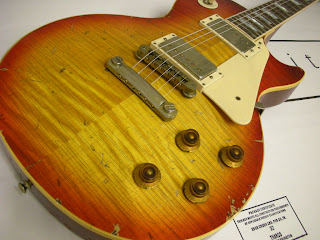We JUST landed this amazing relic'd Gibson LP from Bill Nash. Its a LP Standard, which has been stripped and completely become victim to the nash treatment. The neck is the 60's profile, and with the wear on the back, is one of the nicest feeling LP necks we have seen in a LONG time.
Unfortunately this one is already sold, but we hope to get more of these coming through soon.
Here is the description from Bill Nash:
"These are real Gibson guitars that I purchase with the intention of doing a complete make over. There are a few models that make good candidates for this, depending on the final color (plain, flame or gold top). The faded standards, the classic standards and classic plus standards are all possibilities as a staring piece as long as they are in NOS condition when they land.
First step is to completely disassemble and separate the parts that will be aged and re-used, from the parts that we reject and replace. The “keeper” parts are then aged.
The finish, which is sometimes rather thick, is stripped off down to the bare wood. At this point some get stains applied, if required to get the desired color. Then the guitar gets re-finished in 100% nitrocellulose lacquer, keeping it as thin as possible to enable superior resonance. We do a variety of takes on the lemon, cherry, faded, un-burst, plain and gold top looks.
After curing, the guitar gets the complete aging treatment and is then frets are re-worked and dressed to our specs, then we are ready for re-assembly.
The pickups are replaced with what many of you may balk at as there are so many opinions about Les Paul pickups and tone out there. As always, I simply build a guitar that I would use and leave it at that. So, in my arsenal of personal guitars, my favorite and most versatile LP setup is using a DiMarzio Bluesbucker in the Neck and a DiMarzio Air Norton in the Bridge.
We re-wire the guitar so the pickups breathe better as well as use the neck pickup’s tone control as a coil tap for the Bluesbucker, which gives you an amazing strat-like sound from that pickup. Between 1 and 8 on the tone knob it works as a regular tone control, between 9 and 10 it shuts off the second/dummy coil. This gives you a tap without adding switches of push pull pots.
The Air Norton give you bigger output and rich harmonics without going over the top into the tone spectrum of faceless, modern, high output sound that so many specialized humbuckers are susceptible to. These pickups have a lower string pull and a much higher sensitivity to your dynamics and playing style.
If you care for more info on the pickup selection, setup etc., read on……
My problem with stock Les Pauls is that the pickups never seem truly matched to each other or the position that they inhabit. The neck pickup will sound to fat and lack clarity and character. The bridge will often sound harsh or weak. The middle position (both pickups together) has an incredible potential for sparkle and quack, but no stock Les Paul, I have had, other than an actual ‘59 burst had this. I always looked for a paul that could actually use the neck pickup for rhythm, but if I set my amps for that, then the bridge pickup sounded harsh and weak. If setting the amp for a smooth, but well driven sound from the bridge, then your neck pickup is overly thick and un-clear. Does this sound familiar?
Also, as many of you may have figured out, the method Gibson uses for wiring the pots is not optimum. The tendency towards the guitar getting muddy or sounding choked when anywhere but “10“. This gets re-worked when we re-wire.
Gibson installs frets on the fretboard prior to it getting glued to the neck and body. Maybe they do it as it is easier to do it that way, but it can really lead to all sort of fret issues (buzzing, fret outs, high action, dead spots etc). What happens is the neck and body glue, moisture, and all of the underlying structure will shrink, expand and or settle. The fretboard (and frets) will now adjust itself to the changes and you and up with “lumpy gravy”. The most noticeable and common issue is the hump at about the 14th fret, right where the neck gets really thick before it hit’s the body. So what we do is now re-work the neck and frets and take care of this to give the player better action, playability, sustain, bending etc."
Subscribe to:
Post Comments (Atom)








No comments:
Post a Comment